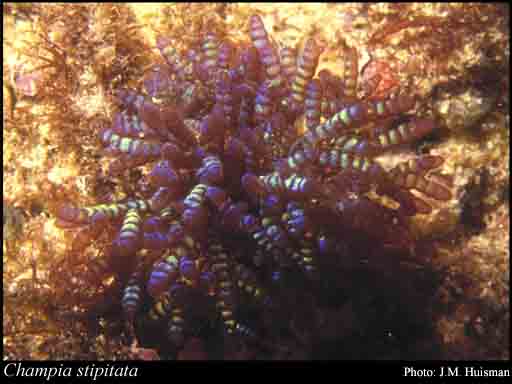- Reference
- Marine Plants of Australia 131, 285-286 (2000)
- Conservation Code
- Not threatened
- Naturalised Status
- Native to Western Australia
- Name Status
- Current

Scientific Description
Habit and structure. Thallus erect, occasionally decumbent, to 5 cm tall, red, with numerous percurrent primary axes arising from a cartilaginous stipe. Branching subopposite to sparse. Axes terete, narrow near the base, broadening to 3.0–3.5 mm diam. near the apex, segmented with slight to moderate constrictions 1.0–2.5 mm apart. Structure multiaxial, hollow; outer cellular layer composed of 1 or 2 inner layers of large colourless cells (70.110 × 50.80 µm in surface view), when mature with slightly to strongly pigmented surface cells borne in the interstitial spaces. Inner surface lined with longitudinal filaments bearing lateral vesicular cells 15–25 µm diam. Longitudinal filaments restricted to the periphery, with 4 complete cells and 2 partial cells per segment. Diaphragms 1 cell thick.
Reproduction. Cystocarps protuberant, hemispherical, 500– 800 µm diam. Tetrasporangia intercalary in an unmodified cortex, 40–50 × 30–40 µm, tetrahedrally divided. Spermatangia unknown.
Distribution. Known from Cape Peron north to Darwin, Western Australia and Papua New Guinea.
Habitat. Generally epilithic in the lower intertidal and subtidal
[After J.M. Huisman in Algae of Australia: Marine Benthic Algae of North-western Australia, 2. Red Algae: 311 (2018)]
Distribution
- IBRA Regions
- Carnarvon, Dampierland, Pilbara, Swan Coastal Plain.
- IBRA Subregions
- Cape Range, Perth, Pindanland, Roebourne.
- IMCRA Regions
- Abrolhos Islands, Canning, Central West Coast, Kimberley, Leeuwin-Naturaliste, Ningaloo, Pilbara (nearshore), Pilbara (offshore).
- Local Government Areas (LGAs)
- Ashburton, Broome, Carnarvon, Cockburn, Dandaragan, Exmouth, Greater Geraldton, Karratha, Rockingham, South Perth, Wyndham-East Kimberley.